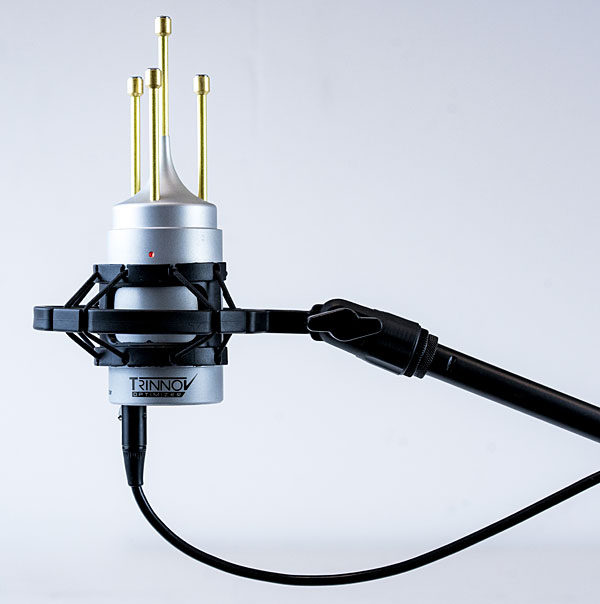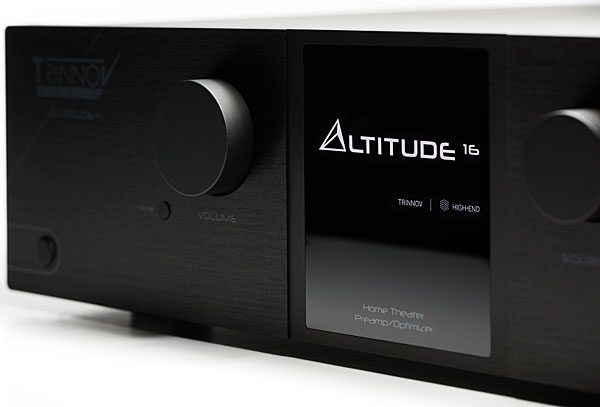Trinnov Audio Altitude16 Surround Sound Processor Review Page 2
Even though I was mostly pleased with the results, I reached out to Chuck Back, Trinnov Audio's US Managing Director, to help me further refine my Optimizer settings. Connecting with the Altitude16 over the internet, Chuck discovered that I didn't have the 3D mic pointed directly at the center speaker during my auto-calibration, so he asked me to rotate it about a quarter- inch and we ran another series of measurements. While still not perfect, the error was within one degree, which he said was acceptable.

My seven main speakers are from M&K (S150 LCRs across the front and SS550s for the rear and back surrounds), and it just so happened that Chuck worked for the company for over 20 years and knew the speakers intimately. He manually applied a target curve to the Altitude16 customized specifically for my M&Ks, and it transported me to audio heaven—my system had never sounded so good!
The Altitude16 has several software features that I found to be fun and useful. The Dolby Atmos Object Viewer displays a three-dimensional depiction of your room and indicates which speakers are active during playback. Viewing it, you'll quickly discover that some Atmos soundtracks make much more active use of overhead speakers than others. Another valuable tool is having the ability to control the processor's output. This essentially provides a mixing board so you can mute channels during playback or isolate a single channel. While that's not something you'd use every day, it's a great way to highlight how prominent the center channel is in a soundtrack mix, or to demonstrate the contribution of overhead effects channels.
Performance
After living with Trinnov's processor for a month, I fell in love with it. The company was founded on the premise of providing realistic 3D sound and the Altitude 16 delivers that in abundance. It was able to take my multipurpose space (the room opens up to another area of the house) and make it sound like a fully enclosed theater. No other room correction system I've evaluated has performed as effectively—the Trinnov Optimizer is literally in a class by itself.

Right out of the gate, my collection of Dolby Atmos demo discs showcased how great the processor was. Whether it was trailers that emphasized the overhead speakers, or music videos (I'm partial to Enrique Iglesias' "Bailando"), "amazing" wouldn't even begin to describe the experience. Discrete pinpoint sound effects moved around the room in a precise manner, while the Optimizer's bass management allowed for a seamless transition from my main speakers to the subs without any audible peaks or dips—like I said above, my system never sounded better.
The Greatest Showman is one of my favorite movies so far this century, and its Atmos soundtrack is to die-for. (According to Trinnov, Greg Wells, Showman's sound mixer, uses a Trinnov ST2 Pro processor for his studio work.) Watching the opening scene with the Altitude16, bass impact was off the charts and Hugh Jackman's voice never lost intelligibility. One thing I noted about the Altitude16 was that I never felt any ear fatigue even after a long listening session at or close to reference level. The sound was consistently balanced and natural: highs were clean, lows punchy and dynamic, the midrange full-bodied and inviting.
To prepare for the premiere of Godzilla vs. Kong on HBO Max, I watched a 2014 reboot of Godzilla that had just been released on Ultra HD Blu-ray with a remixed Dolby Atmos track. This is arguably one of the best-sounding mixes to come out of Hollywood in the last 10 years, and it certainly didn't disappoint with the Trinnov processor in my system. The soundtrack has enough LFE impact to wake the dead, but the Altitude 16 really distinguished itself through its ability to widen both the vertical and horizontal dimensions of the soundstage. Helicopter fly-bys didn't just swoop overhead but conveyed a precise sense of the aircraft's altitude. And the train attack sequence was simply jaw-dropping, with discrete effects bombarding the room as Godzilla emerged and all hell broke loose.
For stereo music-listening, I streamed numerous FLAC-encoded titles stored on my home server using a Logitech Squeezebox. Before I knew it, hours had passed as I advanced from track to track. I set up two separate outputs for stereo sources—one straight two-channel and the other processed in Auro-3D using the Auro-Matic upmixer. I've owned an Auro-3D capable processor in the past, but it didn't sound nearly as refined as what I heard with the Trinnov, and as time went on, I found myself more exhilarated by the Auro-3D upmix versus the standard stereo version. It was as if I were transported directly into a live concert setting with every track I listened to.
Speaking of concerts, music performances mixed in Atmos really highlighted the Altitude16's audio prowess. I started with the John Williams Live in Vienna concert Blu-ray, a disc that offers multiple audio format options including Dolby Atmos and both 5.1 and 2.0 24-bit/48 kHz DTS-HD Master Audio tracks. Listening in Atmos, my favorite of the three, "The Imperial March" from Star Wars sounded powerful, dynamic, and completely mesmerizing. I've never been to the Vienna concert venue, but after that experience I doubt I'll need to because the Altitude 16 delivered an authentic- sounding rendition of its superb acoustics and spaciousness.
Ergonomics
As much as I appreciated the Altitude16's performance, it does have a number of minor quirks that need to be mentioned. First, since it's PC-based, it takes nearly a minute to power up. This wasn't a big deal for me because it takes nearly that long for my JVC RS2000 projector to warm up, but it might be an issue for others. To minimize this concern, Trinnov recommends that you leave the processor powered on 24/7 and reboot it once per week—not exactly green, but effective. (I ended up setting up a "Sleep" profile that would turn off my system's amplifiers when the processor wasn't in use.)
A second quirk is that HDMI lock on an audio signal can take up to 3 seconds, which made TV channel-surfing and fast- forwarding through shows on my TiVo DVR a bit of a drag. On the plus side, the Altitude 16's HDMI video lock is possibly the fastest I've ever experienced in an A/V processor.
Finally, the Trinnov has an annoying green LED—part of the computer motherboard— that blinks every couple of seconds, beaming light through the heat vents on the unit's top surface. This won't be a concern for users with a dedicated equipment room, but for others it could become an issue depending on where you have gear situated in your theater.
Conclusion
If I haven't already made it clear, I absolutely loved Trinnov's Altitude16, which is by far the best-sounding surround sound processor I've had the privilege to use. While I was initially overwhelmed by the complexity of the software interface, in time I was able to navigate it with ease even though I've barely scratched the surface of the processor's capabilities. Fortunately, I'll have plenty of time to dig into the Altitude16 because I've made it a permanent fixture in my system. Sure, it's by far the most expensive piece of gear I own, but after putting two kids through college it's nice to finally spend some money on myself versus sending a check to the California University system. Needless to say, this receives my highest recommendation and I'm putting my money where my mouth is.




























































